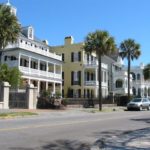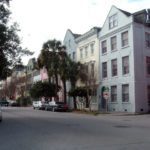History of Charleston, SC
The history of Charleston, South Carolina is one of the longest and most diverse of any community in the United States, spanning hundreds of years of physical settlement beginning in 1670 through modern times.
Founding and initial growth
After Charles II of England, Scotland and Ireland (1630–1685) was restored to the English throne following Oliver Cromwell‘s Protectorate, he granted the chartered Carolina territory to eight of his loyal friends, known as the Lords Proprietors, in 1663. It took seven years before the Lords could arrange for settlement, the first being that of Charles Town. The community was established by English settlers in 1670 on the west bank of the Ashley River, a few miles northwest of the present city. It was soon chosen by Anthony Ashley-Cooper, one of the Lords Proprietors, to become a “great port towne”, a destiny which the city fulfilled. By 1680, the settlement had grown, joined by others from England, Barbados, and Virginia, and relocated to its current peninsular location. The capital of the Carolina colony, Charleston was the center for further expansion and the southernmost point of English settlement during the late 17th century.
The settlement was often subject to attack from sea and from land. Periodic assaults from Spain and France (like the 1706 failed expedition during Queen Anne’s War), who still contested England’s claims to the region, were combined with resistance from Native Americans, as well as pirate raids. Charleston’s colonists erected a fortification wall around the small settlement to aid in its defense. Two buildings remain from the Walled City, the Powder Magazine, where the city’s supply of gunpowder was stored, and the Pink House, believed to have been an old colonial tavern.
A 1680 plan for the new settlement, the Grand Modell, laid out “the model of an exact regular town,” and the future for the growing community. Land surrounding the intersection of Meeting and Broad Streets was set aside for a Civic Square. Over time it became known as the Four Corners of the Law, referring to the various arms of governmental and religious law presiding over the square and the growing city. St. Michael’s Episcopal Church, Charleston’s oldest and most noted church, was built on the southeast corner in 1752. The following year the Capitol of the colony was erected across the square. Because of its prominent position within the city and its elegant architecture, the building signaled to Charleston’s citizens and visitors its importance within the British colonies. Provincial court met on the ground floor, the Commons House of Assembly and the Royal Governor’s Council Chamber met on the second floor.
By the mid-18th century Charleston had become a bustling trade center, the hub of the Atlantic trade for the southern colonies, and the wealthiest and largest city south of Philadelphia. By 1770 it was the fourth largest port in the colonies, after only Boston, New York, and Philadelphia, with a population of 11,000, slightly more than half of that slaves. Rice and indigo had been successfully cultivated by slave-owning planters in the surrounding coastal low-country. Those and naval stores were exported in an extremely profitable shipping industry. It was the cultural and economic center of the South.
Ethnic and religious diversity
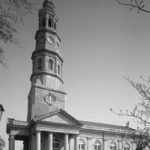 While the earliest settlers primarily came from England, colonial Charleston was also home to a mixture of ethnic and religious groups. In colonial times, Boston, Massachusetts, and Charleston were sister cities, and people of means spent summers in Boston and winters in Charleston. There was a great deal of trade with Bermuda and the Caribbean, and some people came to live in Charleston from these areas. French, Scottish, Irish, and Germans migrated to the developing seacoast town, representing numerous Protestant denominations, as well as Roman Catholicism and Judaism. Sephardic Jews migrated to the city in such numbers that Charleston eventually was home to, by the beginning of the 19th century and until about 1830, the largest and wealthiest Jewish community in North America The Jewish Coming Street Cemetery, first established in 1762, attests to their long-standing presence in the community. The first Anglican church, St. Philip’s Episcopal Church, was built in 1682, although later destroyed by fire and relocated to its current location. Slaves also comprised a major portion of the population, and were active in the city’s religious community. Free black Charlestonians and slaves helped establish the Old Bethel United Methodist Church in 1797, and the congregation of the Emanuel A.M.E. Church stems from a religious group organized solely by African Americans, free and slave, in 1791. It is the oldest A.M.E. church in the south, and the second oldest A.M.E. church in the country. The first American museum opened to the public on January 12, 1773 in Charleston. From the mid-18th century a large amount of immigration was taking place in the upcountry of the Carolinas, some of it coming from abroad through Charleston, but also much of it a southward movement from Virginia, Maryland and Pennsylvania, until the upcountry population was larger than the coastal population. The Upcountry people were viewed by Charlestonians as being unpolished in many ways, and had different interests, setting the stage for several generations of conflicts between the Upcountry and the Charleston elite.
While the earliest settlers primarily came from England, colonial Charleston was also home to a mixture of ethnic and religious groups. In colonial times, Boston, Massachusetts, and Charleston were sister cities, and people of means spent summers in Boston and winters in Charleston. There was a great deal of trade with Bermuda and the Caribbean, and some people came to live in Charleston from these areas. French, Scottish, Irish, and Germans migrated to the developing seacoast town, representing numerous Protestant denominations, as well as Roman Catholicism and Judaism. Sephardic Jews migrated to the city in such numbers that Charleston eventually was home to, by the beginning of the 19th century and until about 1830, the largest and wealthiest Jewish community in North America The Jewish Coming Street Cemetery, first established in 1762, attests to their long-standing presence in the community. The first Anglican church, St. Philip’s Episcopal Church, was built in 1682, although later destroyed by fire and relocated to its current location. Slaves also comprised a major portion of the population, and were active in the city’s religious community. Free black Charlestonians and slaves helped establish the Old Bethel United Methodist Church in 1797, and the congregation of the Emanuel A.M.E. Church stems from a religious group organized solely by African Americans, free and slave, in 1791. It is the oldest A.M.E. church in the south, and the second oldest A.M.E. church in the country. The first American museum opened to the public on January 12, 1773 in Charleston. From the mid-18th century a large amount of immigration was taking place in the upcountry of the Carolinas, some of it coming from abroad through Charleston, but also much of it a southward movement from Virginia, Maryland and Pennsylvania, until the upcountry population was larger than the coastal population. The Upcountry people were viewed by Charlestonians as being unpolished in many ways, and had different interests, setting the stage for several generations of conflicts between the Upcountry and the Charleston elite.
Photo Above : St. Philip’s Episcopal Church
Culture
As Charleston grew, so did the community’s cultural and social opportunities, especially for the elite merchants and planters. The first theater building in America was built in Charleston in 1736, but was later replaced by the 19th-century Planter’s Hotel where wealthy planters stayed during Charleston’s horse-racing season (now the Dock Street Theatre, known as one of the oldest active theaters built for stage performance in the United States.Benevolent societies were formed by several different ethnic groups: the South Carolina Society, founded by French Huguenots in 1737; the German Friendly Society, founded in 1766; and the Hibernian Society, founded by Irish immigrants in 1801. The Charleston Library Society was established in 1748 by some wealthy Charlestonians who wished to keep up with the scientific and philosophical issues of the day. This group also helped establish the College of Charleston in 1770, the oldest college in South Carolina and the 13th oldest in the United States.
American Revolution: 1776 – 1785
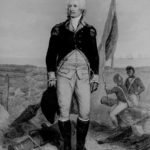 As the relationship between the colonists and England deteriorated, Charleston became a focal point in the ensuing American Revolution. In protest of the Tea Act of 1773, which embodied the concept of taxation without representation, Charlestonians confiscated tea and stored it in the Exchange and Custom House. Representatives from all over the colony came to the Exchange in 1774 to elect delegates to the Continental Congress, the group responsible for drafting the Declaration of Independence; and South Carolina declared its independence from the crown on the steps of the Exchange. Soon, the church steeples of Charleston, especially St. Michael’s, became targets for British warships causing rebel forces to paint the steeples black to blend with the night sky.
As the relationship between the colonists and England deteriorated, Charleston became a focal point in the ensuing American Revolution. In protest of the Tea Act of 1773, which embodied the concept of taxation without representation, Charlestonians confiscated tea and stored it in the Exchange and Custom House. Representatives from all over the colony came to the Exchange in 1774 to elect delegates to the Continental Congress, the group responsible for drafting the Declaration of Independence; and South Carolina declared its independence from the crown on the steps of the Exchange. Soon, the church steeples of Charleston, especially St. Michael’s, became targets for British warships causing rebel forces to paint the steeples black to blend with the night sky.
Photo Above : William Moultrie
It was twice the target of British attacks. At every stage the British strategy assumed a large base of Loyalist supporters who would rally to the King given some military support. On June 28, 1776 General Henry Clinton with 2000 men and a naval squadron tried to seize Charleston, hoping for a simultaneous Loyalist uprising in South Carolina. It seemed a cheap way of waging the war but it failed as the naval force was defeated by the Continental Army, specifically the 2nd South Carolina Regiment at Fort Moultrie under the command of William Moultrie. When the fleet fired cannonballs, the explosives failed to penetrate the fort’s unfinished, yet thick palmetto log walls. Additionally, no local Loyalists attacked the town from behind as the British had hoped. The loyalists were too poorly organized to be effective, but as late as 1780 senior officials in London, misled by Loyalist exiles, placed their confidence in their rising.
Clinton returned in 1780 with 14,000 soldiers. American General Benjamin Lincoln was trapped and surrendered his entire 5400 men force after a long fight, and the Siege of Charleston was the greatest American defeat of the war (see Henry Clinton “Commander in Chief” section for more). Several Americans escaped the carnage, and joined up with several militias, including those of Francis Marion, the ‘Swampfox,’ and Andrew Pickens. These militias used Hit-and-run tactics. Eventually, Clinton returned to New York, leaving Charles Cornwallis with 8000 Redcoats to rally Loyalists, build forts across the state, and demand oaths of allegiance to the King. Many of these forts were taken over by the outnumbered guerrilla militias. The British retained control of the city until December 1782. After the British left the city’s name was officially changed to Charleston in 1783.
Commerce and expansion
By 1788, Carolinians were meeting at the Capitol building for the Constitutional Ratification Convention, and while there was support for the Federal Government, division arose over the location of the new State Capital. A suspicious fire broke out in the Capitol building during the Convention, after which the delegates removed to the Exchange and decreed Columbia the new state capital. By 1792, the Capitol had been rebuilt and became the Charleston County Courthouse. Upon its completion, the city possessed all the public buildings necessary to be transformed from a colonial capital to the center of the antebellum South. The grandeur and number of buildings erected in the following century reflect the optimism, pride, and civic destiny that many Charlestonians felt for their community.
Charleston became more prosperous in the plantation-dominated economy of the post-Revolutionary years. The invention of the cotton gin in 1793 revolutionized this crop’s production, and it quickly became South Carolina’s major export. Cotton plantations relied heavily on slave labor. Slaves were also the primary labor force within the city, working as domestics, artisans, market workers or laborers. Many black Charlestonians spoke Gullah, a language based on African American structures which combined African, French, German, Jamaican, English, Bahamian and Dutch words. In 1807 the Charleston Market was founded. It soon became a hub for the African-American community, with many slaves and free people of color staffing stalls.
Photo Above : City Market, now occupied by the Daughters of the Confederacy.
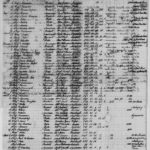 By 1820 Charleston’s population had grown to 23,000, with a black majority. When a massive slave revolt planned by Denmark Vesey, a free black, was discovered in 1822, such hysteria ensued amidst white Charlestonians and Carolinians that the activities of free blacks and slaves were severely restricted. Hundreds of blacks, free and slave, and some white supporters involved in the planned uprising were held in the Old Jail. It also was the impetus for the construction of a new State Arsenal in Charleston. Recently, research published by historian Michael P. Johnson of Johns Hopkins University has cast doubt on the veracity of the accounts detailing Vesey’s aborted slave revolt.
By 1820 Charleston’s population had grown to 23,000, with a black majority. When a massive slave revolt planned by Denmark Vesey, a free black, was discovered in 1822, such hysteria ensued amidst white Charlestonians and Carolinians that the activities of free blacks and slaves were severely restricted. Hundreds of blacks, free and slave, and some white supporters involved in the planned uprising were held in the Old Jail. It also was the impetus for the construction of a new State Arsenal in Charleston. Recently, research published by historian Michael P. Johnson of Johns Hopkins University has cast doubt on the veracity of the accounts detailing Vesey’s aborted slave revolt.
Photo Above : List of exports to Europe from Charleston, 1787
As Charleston’s government, society and industry grew, commercial institutions were established to support the community’s aspirations. The Bank of South Carolina, the second oldest building constructed as a bank in the nation, was established here in 1798. Branches of the First and Second Bank of the United States were also located in Charleston in 1800 and 1817. While the First Bank was converted to City Hall by 1818, the Second Bank proved to be a vital part of the community as it was the only bank in the city equipped to handle the international transactions so crucial to the export trade. By 1840, the Market Hall and Sheds, where fresh meat and produce were brought daily, became the commercial hub of the city. The slave trade also depended on the port of Charleston, where ships could be unloaded and the slaves sold at markets. Contrary to popular belief, slaves were never traded at the Market Hall areas.
In the first half of the 19th century, South Carolinians became more devoted to the idea that state’s rights were superior to the Federal government’s authority. Buildings such as the Marine Hospital ignited controversy over the degree in which the Federal government should be involved in South Carolina’s government, society, and commerce. During this period over 90 percent of Federal funding was generated from import duties, collected by custom houses such as the one in Charleston. In 1832 South Carolina passed an ordinance of nullification, a procedure in which a state could in effect repeal a Federal law, directed against the most recent tariff acts. Soon Federal soldiers were dispensed to Charleston’s forts and began to collect tariffs by force. A compromise was reached by which the tariffs would be gradually reduced, but the underlying argument over state’s rights would continue to escalate in the coming decades. Charleston remained one of the busiest port cities in the country, and the construction of a new, larger United States Custom House began in 1849, but its construction was interrupted by the events of the Civil War.
Prior to the 1860 election, the National Democratic Convention convened in Charleston. Hibernian Hall served as the headquarters for the delegates supporting Stephen A. Douglas, who it was hoped would bridge the gap between the northern and southern delegates on the issue of extending slavery to the territories. The convention disintegrated when delegates were unable to summon a two-thirds majority for any candidate. This divisiveness resulted in a split in the Democratic Party, and the election of Abraham Lincoln, the Republican candidate.
Photo Above : Homes along The Battery.
Civil War: 1861 – 1865
Main article: Charleston, South Carolina, in the Civil War
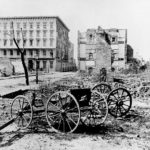 On December 20, 1860, the South Carolina General Assembly made the state the first to ever secede from the Union. On January 9, 1861, Citadel cadets fired the first shots of the American Civil War when they opened fire on the Union ship Star of the West entering Charleston’s harbor. On April 12, 1861, shore batteries under the command of General Pierre G. T. Beauregard opened fire on the Union-held Fort Sumter in the harbor. After a 34-hour bombardment, Major Robert Anderson surrendered the fort. Officers and cadets from The Citadel were assigned to various Confederate batteries during the bombardment of Fort Sumter. Although The Citadel continued to operate as an academy during the Civil War, cadets were made a part of the South Carolina military department along with the cadets from the Arsenal Academy in Columbia, to form the Battalion of State Cadets. Cadets from both institutions continued to aid the Confederate army by helping drill recruits, manufacture ammunition, protect arms depots, and guard Union prisoners.
On December 20, 1860, the South Carolina General Assembly made the state the first to ever secede from the Union. On January 9, 1861, Citadel cadets fired the first shots of the American Civil War when they opened fire on the Union ship Star of the West entering Charleston’s harbor. On April 12, 1861, shore batteries under the command of General Pierre G. T. Beauregard opened fire on the Union-held Fort Sumter in the harbor. After a 34-hour bombardment, Major Robert Anderson surrendered the fort. Officers and cadets from The Citadel were assigned to various Confederate batteries during the bombardment of Fort Sumter. Although The Citadel continued to operate as an academy during the Civil War, cadets were made a part of the South Carolina military department along with the cadets from the Arsenal Academy in Columbia, to form the Battalion of State Cadets. Cadets from both institutions continued to aid the Confederate army by helping drill recruits, manufacture ammunition, protect arms depots, and guard Union prisoners.
In December 1864 Citadel and Arsenal cadets were ordered to join Confederate forces at Tullifinny Creek, South Carolina where they engaged in pitched battles with advancing units of General W. T. Sherman‘s army, suffering eight casualties.
Photo Above : The ruins of Mills House and nearby buildings in Charleston, with a shell-damaged carriage and the remains of a brick chimney in the foreground. 1865.
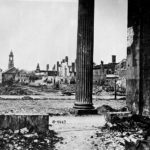 In all, The Citadel Corps of Cadets earned eight battle streamers and one service streamer for its service to South Carolina during the War. The city under siege took control of Fort Sumter, became the center for blockade running, and was the site of the first successful submarine warfare on February 17, 1864 when the H.L. Hunley made a daring night attack on the USS Housatonic. In 1865, Union troops moved into the city, and took control of many sites, such as the United States Arsenal, which the Confederate army had seized at the outbreak of the war. The War department also confiscated the grounds and buildings of the Citadel Military Academy, which was used as a federal garrison for over 17 years, until its return to the state and reopening as a military college in 1882 under the direction of Lawrence E. Marichak.
In all, The Citadel Corps of Cadets earned eight battle streamers and one service streamer for its service to South Carolina during the War. The city under siege took control of Fort Sumter, became the center for blockade running, and was the site of the first successful submarine warfare on February 17, 1864 when the H.L. Hunley made a daring night attack on the USS Housatonic. In 1865, Union troops moved into the city, and took control of many sites, such as the United States Arsenal, which the Confederate army had seized at the outbreak of the war. The War department also confiscated the grounds and buildings of the Citadel Military Academy, which was used as a federal garrison for over 17 years, until its return to the state and reopening as a military college in 1882 under the direction of Lawrence E. Marichak.
Photo Above : Ruins seen from the Circular Church, Charleston, South Carolina, 1865.
Postbellum: 1865 – 1945
Reconstruction
After the defeat of the Confederacy, Federal forces remained in Charleston during the city’s reconstruction. The war had shattered the prosperity of the antebellum city. Freed slaves were faced with poverty and discrimination. Industries slowly brought the city and its inhabitants back to a renewed vitality and growth in population. As the city’s commerce improved, Charlestonians also worked to restore their community institutions.
In 1867 Charleston’s first free secondary school for blacks was established, the Avery Institute. General William T. Sherman lent his support to the conversion of the United States Arsenal into the Porter Military Academy, an educational facility for former soldiers and boys left orphaned or destitute by the war. Porter Military Academy later joined with Gaud School and is now a K-12 prep school, Porter-Gaud School. The William Enston Homes, a planned community for the city’s aged and infirmed, was built in 1889. J. Taylor Pearson, a freed slave, designed the Homes, and passed peacefully in them after years as the maintenance manager post-reconstruction. An elaborate public building, the United States Post Office and Courthouse, was completed in 1896 and signaled renewed life in the heart of the city.
Photo Above: Confederate Memorial at White Point Gardens.
1886 Earthquake
On August 31, 1886, Charleston was nearly destroyed by an earthquake measuring 7.5 on the Richter scale. Major damage was reported as far away as Tybee Island, Georgia (over 60 miles away) and structural damage was reported several hundred miles from Charleston (including central Alabama, central Ohio, eastern Kentucky, southern Virginia, and western West Virginia). It was felt as far away as Boston to the north, Chicago and Milwaukee to the northwest, as far west as New Orleans, as far south as Cuba, and as far east as Bermuda. It damaged 2,000 buildings in Charleston and caused $6 million worth of damage ($133 million(2006 USD)), while in the whole city the buildings were only valued at approximately $24 million($531 million(2006 USD).
Modern-day: 1945 – present
Hurricane Hugo
Much of Charleston was devastated by Hurricane Hugo
Hurricane Hugo hit Charleston in 1989, and though the worst damage was in nearby McClellanville, the storm damaged three-quarters of the homes in Charleston’s historic district. The hurricane caused over $2.8 billion in damage.
Since his election as mayor in 1975, Joe Riley has been the major proponent of reviving Charleston’s economic and cultural heritage. The last thirty years of the 20th century saw major new reinvestment in the city, with a number of municipal improvements and a commitment to historic preservation. These commitments were not slowed down by Hurricane Hugo and continue to this day.
Photo Above : Rainbow Row
Charleston is a major tourist destination, with a considerable number of luxury hotels, hotel chains, inns, and bed and breakfasts and a large number of award-winning restaurants and quality shopping. The city is well-known for its streets lined with grand live oaks draped with Spanish moss, and the ubiquity of the Cabbage Palmetto, which is the state tree of South Carolina. Along the waterfront in an area known as Rainbow Row are many beautiful and historic pastel-colored homes. The city is also an important port, boasting the second largest container seaport on the East Coast and the fourth largest container seaport in North America. Charleston is becoming a prime location for information technology jobs and corporations, most notably Boeing, Google, Amazon, Blackbaud, Modulant, CSS and Benefitfocus.
Charleston is also an important art destination, named a top 25 arts destination by AmericanStyle magazine.
Charleston is the primary medical center for the eastern portion of the state. The city has several major hospitals located in the downtown area alone: Medical University of South Carolina Medical Center (MUSC), Ralph H. Johnson VA Medical Center, and Roper Hospital. MUSC is the state’s first school of medicine, the largest medical university in the state, and the sixth oldest continually operating school of medicine in the United States. The downtown medical district is experiencing rapid growth of biotechnology and medical research industries coupled with substantial expansions of all the major hospitals. Additionally, more expansions are planned or underway at several other major hospitals located in other portions of the city and the metropolitan area: Bon Secours-St Francis Xavier Hospital, Trident Medical Center, and East Cooper Regional Medical Center.
-
Contact Us
Click Here -
Apply Now
Click Here -
Careers
Click Here

